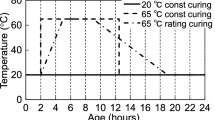Abstract
Fluorescence microscopic examinations were conducted to identify damages induced by restraining autogenous shrinkage. Characteristics of fluorescent areas and their correspondence to autogeneous shrinkage behavior of high strength concretes were discussed. Silica fume concrete exhibited a greater creep potential when loaded at very early ages. The microstructure in sealed concretes with an extremely low water/binder ratio was porous. The vicinity of aggregate grains was more porous and weaker than the bulk matrix in sealed concretes. In addition, sealed silica fume concretes contained many unhydrated cement particles which were profiled by thin gaps between the core cement particles and the surrounding cement paste matrix. These features of microstructure were not observed in water ponded concretes. The detected fluorescent areas may be defects caused by selfdesiccation and autogenous shrinkage. The flaws had little effects on the development of strength. However, the presence of thin gaps around remnant cement particles may increase creep deformation to relieve internal stresses.
Résumé
Des analyses microscopiques fluorescentes ont été réalisées pour identifier les dommages causés par le retrait endogéne. Les caractéristiques des surfaces fluorescentes et leurs liens avec le comportement du retrait endogène du béton à haute résistance, ont été débattus. Le béton fait de fumée de silice a montré une plus grande possibilité de fluage en étant chargé à de très jeunes âges. La microstructure dans les bétons obstrués ayant un rapport eau/liant extrêmement bas, était poreuse. Les environs des grans d'agrégats étaient plus poreux et plus faibles que le volume du modèle des bétons obstrués. De plus, le béton obstrué à base du fumée de silice contenait plusieurs particules de ciment déshydraté qui ont été démontrées par les minces fentes entre le centre des particules de ciment et le contour de la pâte de ciment. Ces faces de la microstructure n'ont pas été observées dans le béton submergé. Les surfaces fluorescentes détectées peuvent être défectueuses à cause de l'auto-dessiccation et du retrait endogène. Les défauts ont peu d'effets sur le développement de la résistance. De toutes façons, la présence de mincesffentes autour des restes de particules de ciment peut augmenter la déformation du fluage et libérer les contraintes internes.
Similar content being viewed by others
References
Piallère, A. M., Buil, M. and Serrano, J. J., ‘Effect of fiber addition on the autogenous shrinkage of silica fume concrete’,ACI Mat. J. 86 (2) (1989) 139–44.
Kovler, K., ‘Testing system for determining the mechanical behavior of early-age concrete under restrained and free uniaxial shrinkage,’Mater. Struct. 27 (170) (1994) 324–30.
Igarashi, S., Bentur, A. and Kovler, K., ‘Autogenous shrinkage and induced restraining stresses in high strength concrete,’Cem. Concr. Res. 30 (11) (2000) 1701–1707.
Kovler, K., Igarashi, S. and Bentur, A., ‘Tensile creep behavior of high strength concretes at early ages’,Mater. Struct. 32 (219) (1999) 383–87.
Bentur, A., Igarashi, S. and Kovler, K., ‘Control of autogenous shrinkage stresses and cracking in high strength concretes’, in ‘Utilization of High Strength/High Performance Concrete’, Proc. of 5th Intl. Symp., Sandefjord, (June 1999) 1017–26
Bissonnette, B. and Pigeon, M., ‘Tensile creep at early ages of ordinary, silica fume and fiber reinforced concretes’,Cem. Concr. Res. 25 (5) (1995) 1075–85.
Diamond, S., ‘Aspects of concrete porosity revisited’,Cem. Concr. Res. 29 (8) (1999) 1181–88.
Wu, Z.-Q. and Young, J. F., ‘The hydration of tricalcium silicate in the presence of colloidal silica,’J. Mat. Sci.,19 (1984) 3477–86.
Author information
Authors and Affiliations
Additional information
Editorial Note Dr. Shin-ichi Igarashi and Prof. Dr. Mitsunori Kawamura are RILEM Senior Members. They participate in the work of RILEM TC 181-EAS. ‘Early age shrinkage induced stresses and cracking in cementitious systems’.
Rights and permissions
About this article
Cite this article
Igarashi, S., Kawamura, M. Effects of microstructure on restrained autogenous shrinkage behavior in high strength concretes at early ages. Mat. Struct. 35, 80–84 (2002). https://doi.org/10.1007/BF02482105
Received:
Accepted:
Issue Date:
DOI: https://doi.org/10.1007/BF02482105




